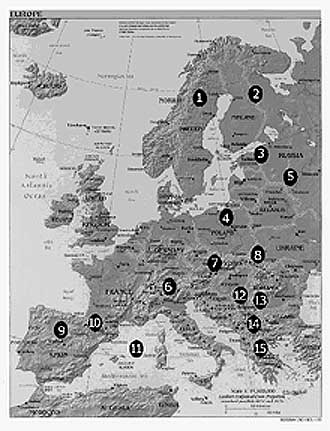

2: Finland, Russian Karelia: An important forest chain in quasi natural condition.
3: Baltic Countries: There are a few old-growth forests and a high number of old semi-natural forests
4: Eastern Europe: The fragments of pristine forests, like the Bialowieza forests in Poland and Belarus provide examples of virgin temperate forests
5: Ukraine, Belarus: swamp and bog forests
6: Alps: Almost pristine forests on some slopes.
7: Danube, Tisza, Sawa basin: Remains of alluvial forests
8: Carpathian Mountains: They have rich and varied forests, with the highest concentration of yew
9: Spanish mountains
10: Pyrenees: Forests with original character and high rates of plant endemism can be encountered. Many forests in the Pyrenees are in a semi-natural state. In the Guadiana River Basin (Southern Spain and Portugal) there are Mediterranean riparian forests, with a large number of tamarisk, poplar, willow, alder, plane tree, ash tree
11 :Mediterranean Region: This region is home for endemic species of trees, typically conifers (Macedonian pine, pinus nigra, juniper woodlands, North-African endemic conifer)
The Mediterranean riparian forests are characterized by poplars, willows, tamarisks, alders, plane trees.
12: Balkan: The Balkan Mountains are rich in endemic species (horse chestnut, Macedonian pine, Bosnian pine, hybrid Greek fir.
13: Bulgaria, FYR Macedonia and Greece: Isolated natural occurrences of horse chestnut.
14: FYR Macedonia, Albania: endemic confessors (Macedonian pine, Bosnia pine, hybrid Greek fir)
15: Aoos Valley: There is an important habitat in Aoos Valley, with more than 20 wood-species.
East from the map, in the
European part of Russia:
Sub-Tundra old-growth forest zone: Almost 2000 km long and 100-200 km
wide zone from Urals to Kola Peninsula, bordering both sides of the arctic
tundra. Luckily, there is sufficient timber further in the South, so these
forests mostly escaped logging.
Archangelsk Oblast and Komi Republic: Under the sub-tundra forests
stretches an area of old-growth forest.
Pechora River: Probably the largest natural boreal forests, part
of the World Heritage Site by UNESCO
Southern Urals: Mixed oak and spruce mountain old-growth forests
Caucasus Mountains, Coasts of the Black Sea: still high amount
of pristine and semi-natural forests
Crimean Mountains: spatches of Mediterranean Forests